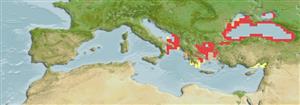Classification / Names
Common names from other countries
Main reference
Size / Peso / Age
Max length : 800 cm TL maschio/sesso non determinato; (Ref. 59043); common length : 215 cm TL maschio/sesso non determinato; (Ref. 3397); Peso massimo pubblicato: 3.2 t (Ref. 59043); Età massima riportata: 118 anni (Ref. 47437)
Length at first maturity
Lm ?, range 200 - ? cm
Ambiente
; marino; acqua dolce; salmastro pelagico; anadromo (Ref. 51243); distribuzione batimetrica 70 - 180 m
Clima / Range
Temperate; 10°C - 20°C (Ref. 2059), preferred 16°C (Ref. 107945); 57°N - 35°N, 17°E - 60°E
Distribuzione
Eurasia: Caspian, Black, Azov and Adriatic Sea basins. Considered critically endangered (Ref. 59043). Appendix III of the Bern Convention (protected fauna). International trade restricted (CITES II, since 1.4.98; CMS Appendix II).
Stati | Aree FAO | Ecosystems | Presenze | Introduzioni
Short description
Spine dorsali (totale): 0; Raggi dorsali molli (totale): 62-73; Spine anali 0; Raggi anali molli: 28 - 41. Snout moderate and pointed, turning slightly upward. Lower lip not continuous, interrupted at center. Barbels oval or flat, leaf-like posteriorly, reaching almost to mouth. Five rows of scutes, dorsal 11-14 (first one smallest), lateral 41-52 on each side, ventral 9-11 on each side. Back ash-grey or greenish, flanks lighter, belly white.
IUCN Red List Status (Ref. 115185)
Threat to humans
Harmless
Human uses
Pesca: commerciale; Acquacoltura: commerciale; Acquario: Acquari pubblici
Strumenti
Special reports
Download XML
Fonti Internet
Estimates of some properties based on models
Phylogenetic diversity index
PD50 = 0.7500 many relatives (e.g. carps) 0.5 - 2.0 few relatives (e.g. lungfishes)
Trophic Level
4.4 ±0.3 se; Based on diet studies.
Resilienza
Molto basso, tempo minimo di raddoppiamento della popolazione più di 14 anni (K=0.1; tm=13-22; tmax=100; Fec=360,000)
Vulnerability
Very high vulnerability (89 of 100)
Price category
